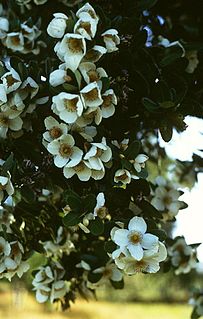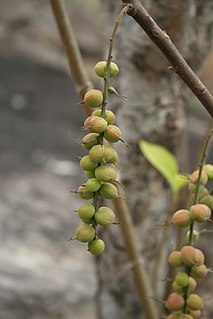
Herring are forage fish, mostly belonging to the family Clupeidae.

Eucryphia is a small genus of trees and large shrubs native to the south temperate regions of South America and coastal eastern Australia, mainly Tasmania. Sometimes placed in a family of their own, the Eucryphiaceae, more recent classifications place them in the Cunoniaceae. There are seven species, two in South America and five in Australia, and several named hybrids.
Bonnetia cordifolia is a species of flowering plant in the Bonnetiaceae family. It is found only in Venezuela.
Aegiphila cordifolia is a species of flowering plant in the family Lamiaceae. It is endemic to Peru, where it occurs in the Amazon rainforest. It is sometimes found in disturbed habitat.

Eucryphia cordifolia, the ulmo, is a species of tree in the family Cunoniaceae. It is found in Chile and Argentina. It is threatened by logging and habitat loss. The natural habitat is along the Andes Range from 38 to 43°S, and up to 700 meters (2300 ft) above sea level. It is a very elegant tree with a thick trunk and wide crown and can become over 12 m (39 ft) high. It blooms in February and March, depending on latitude and altitude. The fruit is a capsule about 1.5 cm (0.6 in) length.
Hopea cordifolia is a species of plant in the family Dipterocarpaceae. It is endemic to Sri Lanka.
Neomitranthes is a genus of plant in family Myrtaceae first described as a genus in 1977. The entire genus is endemic to Brazil.
Neomitranthes langsdorfii is a species of plant in the family Myrtaceae. It is endemic to Brazil.
Shorea cordifolia is a species of plant in the family Dipterocarpaceae. It is endemic to Sri Lanka.
Symplocos cordifolia is a species of plant in the family Symplocaceae. It is endemic to Sri Lanka.

Alchornea cordifolia is a shrub or small tree distributed throughout tropical Africa, it can grow up to 8 metres tall. The plant is used in traditional African medicine. Common name is the Christmas bush.
Bat Conservation International (BCI) is an international nongovernmental organization working to conserve bats and their habitats through conservation, education, and research efforts.

Betula cordifolia, the mountain paper birch is a birch species native to Eastern Canada and the Northeastern United States. Until recently it was considered a variety of Betula papyrifera, with which it shares many characteristics, and it was classified as B. papyrifera var. cordifolia (Regel) Fern.

The World's 25 Most Endangered Primates is a list of highly endangered primate species selected and published by the International Union for Conservation of Nature (IUCN) Species Survival Commission (SSC) Primate Specialist Group (PSG), the International Primatological Society (IPS), Global Wildlife Conservation (GWC), and Bristol Zoological Society (BZS). The IUCN/SSC PSG worked with Conservation International (CI) to start the list in 2000, but in 2002, during the 19th Congress of the International Primatological Society, primatologists reviewed and debated the list, resulting in the 2002–2004 revision and the endorsement of the IPS. The publication was a joint project between the three conservation organizations until the 2012–2014 list when BZS was added as a publisher. The 2018–2020 list was the first time Conservation International was not among the publishers, replaced instead by GWC. The list has been revised every two years following the biannual Congress of the IPS. Starting with the 2004–2006 report, the title changed to "Primates in Peril: The World's 25 Most Endangered Primates". That same year, the list began to provide information about each species, including their conservation status and the threats they face in the wild. The species text is written in collaboration with experts from the field, with 60 people contributing to the 2006–2008 report and 85 people contributing to the 2008–2010 report. The 2004–2006 and 2006–2008 reports were published in the IUCN/SSC PSG journal Primate Conservation,, since then they have been published as independent publications.
Persoonia cordifolia is a species of flowering plant in the family Proteaceae and is endemic to a restricted area in the south of Western Australia. It is an erect, rounded to spreading shrub with smooth, mottled grey bark, broadly heart-shaped leaves and bright yellow flowers borne in groups of two to eight along a rachis up to 25 mm (0.98 in) long.

Dendrocnide cordifolia, commonly known as the stinging tree, is a plant in the nettle family Urticaceae endemic to the Atherton Tablelands, south west of Cairns, Queensland. Contact with the plant results in a painful sting, however the intensity and duration of the pain from this plant is extreme.







